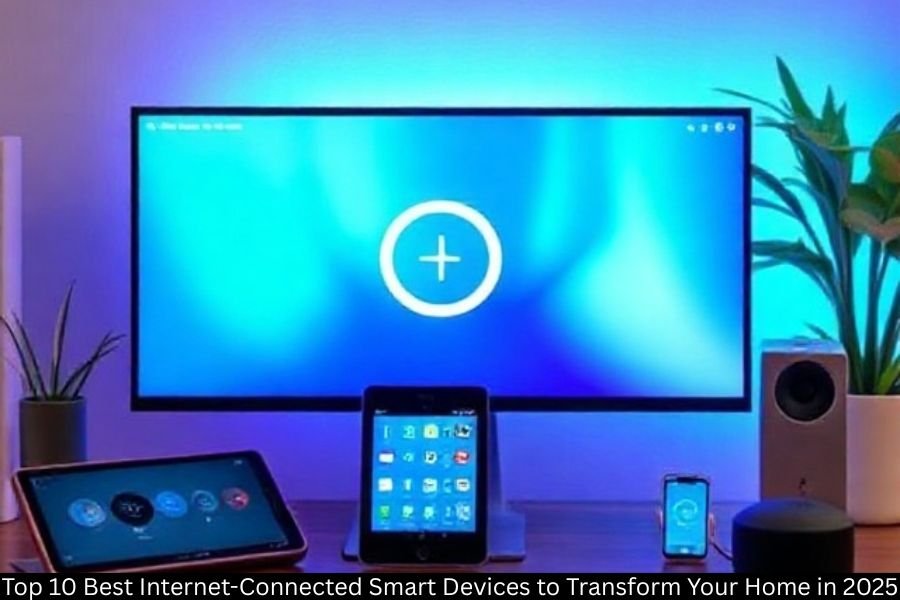The idea of a “smart home” is no longer a science fiction – this is our everyday reality. From Voice Assistants who close the lights from the refrigerator that remind you of buying milk, changing the smart devices associated with the Internet how we live. They make our homes safe, more energy-skilled and a completely more convenient. But with so many options, how do you know which devices are really worth it? Let’s drop it down from the point.
Which devices can be connected to smart homes?
Almost every part of your house can be smart these days. We are talking about lights, thermostats, locks, cameras, speakers, TV and even kitchen equipment. If it plugs – or sometimes it is not – perhaps a smart version is available. Its beauty is that you can find and match equipment from different brands until they are compatible with your hub or auxiliary.
Smart Speaker and Voice Assistant
Smart speaker is often the first step towards automation. Devices like Amazon Eco, Google Nest Hub and Apple Homepod are like the “brain” of your smart home. You can ask them to play music, set reminder, or control your other devices with their voice. They act as the Central Command Center, making everything easier.
Smart Home Hub
While voice assistants are great, sometimes you need a dedicated hub to tie everything together. Smart home hubs act as a bridge between the devices, especially if they use various communication protocols such as jigbi or Z-wave. The popular hub includes Samsung Smartathings, Hubitat and Home Assistant.
Which is the best smart home hub?
It depends on what you want. If you want something simple and user friendly, Samsung Smartathings is a solid pick. For advanced users who prefer adaptation and local control, Hubitat or Home Assistant are powerful options. Apple’s fans may prefer homepod-compatible setup as a hub with homepode. The “best” hub is actually one that fits on your ecosystem and comfort level.
Smart lighting system
Smart lighting is one of the easiest upgrade that you can make. Imagine to demolish lights for movie nights with a voice command or set them to turn on when you go in. You can also sync lights with music or movies for a fun experience.
Smart thermostats
Smart thermostats like Nest and Ecobe save their homes while keeping their home comfortable. They learn your schedule, automatically adjust the temperature, and can be controlled from anywhere through your phone. Over time, they can significantly reduce your utility bills.
Smart safety equipment
Security is a big reason that many people start investing in smart tech. Devices like Ring Video Doorbels, Earlo Camera and August Smart Lock give you peace of mind. You can see who is at your door, lock or unlock from a distance, and even get an alert if something is uncommon – all from your phone.
Smart equipment
Smart home games are also catching equipment. Think of refrigerators that track grocery items, oven you can preheat from a distance, or washing machine that sends you a notification when sending a notice. While some of these feel futuristic, they are quickly becoming mainstreams.
Smart entertainment system
Entertainment has also become smart. Smart TV, Roku, Apple TV and Chromecast let you stream almost anything. Add a smart soundbar or speaker system, and you have got a fully connected living room experience. In addition, you can combine them with voice assistants for hand -free control.
Do smart devices require internet?
Most smart devices require an internet connection to fully work, especially those who rely on cloud storage or remote access. However, some devices (such as some hubs or zigby-based lights) can move locally without internet. He said, having a reliable Wi-Fi connection ensures easy performance.
What is the best internet speed for smart homes?
The best internet speed depends on how many equipment you are driving. As a general rule, 5–10 Mbps per device are recommended. Therefore, if you have found 20 devices, you want at least 200 Mbps to run everything smoothly. Rapid speed also helps with video streaming from cameras and security systems.
Is there a monthly fee for smart homes?
Some devices are independent after purchasing, but others require membership. For example, the ring and arrows charge for video storage. Some hubs or automation services may also have premium tier. Good news? If you choose your devices wisely, you can run a smart home without any monthly fee.
Future of smart homes
The next major step in smart homes is interoperability. With the protocol of the new case, devices of different brands can eventually talk to each other originally. AI- Add powered automation, and your smart home will soon predict your requirements rather than only responding to orders.
conclusion
Smart devices are turning our homes into places that are not only connected, but are also clever about how they work. Whether you are starting small with a smart speaker or going all-in with hub, lighting, thermostats and security systems, the options are endless. The key is to choose devices that fit your lifestyle and ensure that your internet is enough to handle them.
questions to ask
Which devices can be connected to smart homes?
Almost anything – light, thermostats, locks, cameras, equipment, speakers and TVs can be added.
Which smart devices are used in homes?
The most common are smart speakers, lights, thermostats, cameras and security systems.
Which is the best smart home hub?
For ease, Samsung Smartathings, Habitat for adaptation, and Homcits for Apple users are popular options.
Do smart devices require internet?
Most, especially for remote access and cloud features, but some can work locally through the hub.
What is the best internet speed for smart homes?
Target for at least 5-10 Mbps per device. A house with 20 equipment should be approximately 200 Mbps or more.
